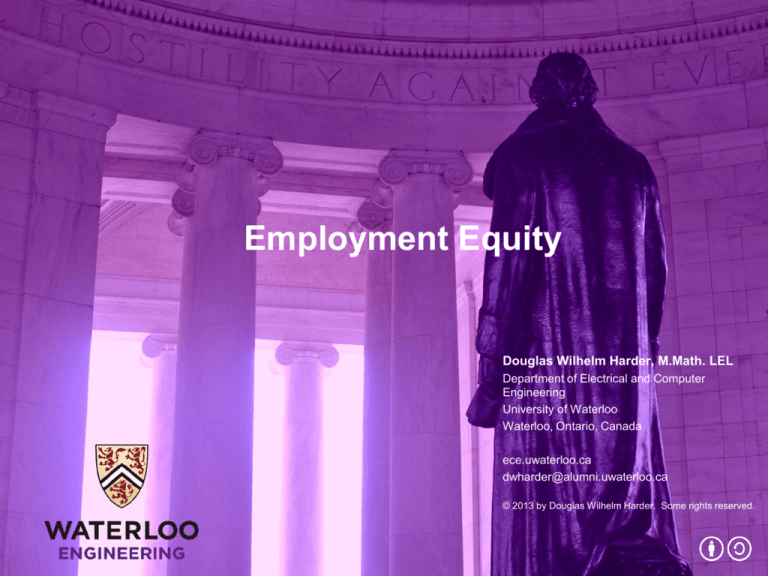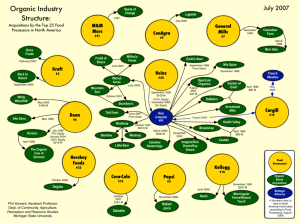
Employment Equity
Douglas Wilhelm Harder, M.Math. LEL
Department of Electrical and Computer
Engineering
University of Waterloo
Waterloo, Ontario, Canada
ece.uwaterloo.ca
dwharder@alumni.uwaterloo.ca
© 2013 by Douglas Wilhelm Harder. Some rights reserved.
Employment Equity
Outline
An introduction to the engineering profession, including:
– Standards and safety
– Law: Charter of Rights and Freedoms, contracts, torts, negligent
malpractice, forms of carrying on business
– Intellectual property (patents, trade marks, copyrights and
industrial designs)
– Professional practice
• Professional Engineers Act
• Professional misconduct and sexual harassment
– Alternative dispute resolution
– Labour Relations and Employment Law
– Environmental Law
2
Employment Equity
Employment Equity Act
The Employment Equity Act requires that employers
proactively introduce employment practices to increase
four designated groups:
–
–
–
–
Women
Persons with disabilities
Aboriginal people
Visible minorities
The focus is that “no person shall be denied employment
opportunities or benefits for reasons unrelated to
ability”
– The Act repeatedly uses the term reasonable accommodation
3
Employment Equity
Employment Equity Act
From the Act:
The purpose of this Act is to achieve equality in the workplace ...
by giving effect to the principle that employment equity means
more than treating persons in the same way but also requires
special measures and the accommodation of differences.
4
Employment Equity
Employment Equity Act
For example,
It is reasonable to accommodate a clerical worker in a
wheelchair by making the workplace wheelchair accessible
It would not be reasonable to, for example, require the Canadian
Forces to employ a physically disabled individual in the infantry:
the nature of the position requires physical ability
5
Employment Equity
Employment Equity Act
Consider a professor who develops a brain tumour:
Under what conditions might a university be required to
accommodate the individual?
– Suppose the tumour affected the motor pathways of the brain
leaving the individual unable to think move, at least initially,
without assistance?
– Suppose the tumour affected the professor’s cognitive abilities
leaving him or her restricted in the ability to do research or teach
6
Employment Equity
Employment Equity Act
Consider an individual develops epilepsy and loses his
or her driving licence:
– The individual is an auto mechanic who may be required to test
drive cars that are being repaired
• What if he is the only employee in a small auto shop?
• What if the employee is one of twelve employed mechanics in a
dealership?
– What if someone looses their licence
due to drunk driving?
7
Employment Equity
Employment Equity Act
What if company executives have their monthly meetings
at the local strip club?
What if the employee washrooms have a stack of
Playboy and Penthouse magazines
Would it be appropriate to give an example of such
magazine covers on this slide? Why or why not?
8
Employment Equity
Employment Equity Act
What steps can be taken to ensure equity?
– Asking the same questions during interviews
– Advertising in such a way so as to not bias against a group
9
Employment Equity
Employment Equity Act
What is not appropriate questions?
– You cannot ask personal questions regarding weight or height
• Exception: the job requires certain requirements
– Questions surrounding physical abilities
• Exception: again, if they apply
– National origin or citizenship
• Exception: if the job requires Canadian citizenship
– Criminal record
• Exception: only to crimes specifically related to the type of
employment, i.e., “Have you been convicted of x”
10
Employment Equity
Employment Equity Act
What is not appropriate questions?
– Social or political affiliations
• Exception: professional organizations or job-related clubs or
hobbies
– Requesting photographs
• Exception: modelling and entertainment
– Marital or family status
• Exceptions:
“Are you willing to relocate?”
“Would you be able to travel?”
• Exceptions must be relevant to the position
11
Employment Equity
Case Study
Fiona Johnstone was a border services officer for the
Canadian Border Services Agency at Pearson
International Airport
– Employees had rotating shifts where shifts could change with as
little as five-days notice
– Static shifts would not be considered for child-care
responsibilities
• In the opinion of CBSA, child-care obligations were the result of
choices that an employee has made and therefore the employer is
not responsible for accommodate such needs
12
Employment Equity
Case Study
After a second child, Johnstone was forced to reduce her
work to part-time levels
– She could not find day-care to accommodate the scheduling
practices
She filed a complaint
– The Canadian Human Rights Tribunal found that the agency
discriminated against Johnstone
– The CBSA appealed but the Federal Court upheld the finding
– In his ruling, Justice Leonard Mandamin said the policy was
“based on the arbitrary assumption that the need for
accommodation on the basis of family obligations was merely
the result of choices that individuals make, rather than legitimate
need.”
13
Employment Equity
Case Study
In 1970, 5 % of members of the top five symphony
orchestras in the United States were women
With the introduction of blind auditions where the
musician is behind a screen, the percentage jumped to
25 % by 1996
Never-the-less, today, the Vienna Philharmonic
Orchestra has at most a handful of women
“In der Kunst kann es kein Quote geben”
“In art, there cannot be any quotas.”
14
Employment Equity
Case Study
In a study by Darity and Mason, 1998, they sent
essentially identical resumes to companies but included
information that exposed the ethnicity of the applicant
– In England, Afro-American, Indian or Pakistani associations were
not called for interviews
– In Australia, Greek or Vietnamese names were again, not called
for interviews
In both cases, Anglo-Saxon associations resulted in
requests for interviews
“Evidence on Discrimination in Employment: Codes of Color, Codes of Gender”,
Journal of Economic Perspectives
15
Employment Equity
References
[1]
[2]
[3]
D.L. Marston, Law for Professional Engineers, 4th Ed., McGraw Hill, 2008.
Julie Vale, ECE 290 Course Notes, 2011.
Wikipedia, http://www.wikipedia.org/
These course slides are provided for the ECE 290 class. The material in it reflects
Douglas Harder’s best judgment in light of the information available to him at the
time of preparation. Any reliance on these course slides by any party for any other
purpose are the responsibility of such parties. Douglas W. Harder accepts no
responsibility for damages, if any, suffered by any party as a result of decisions
made or actions based on these course slides for any other purpose than that for
which it was intended.
16







